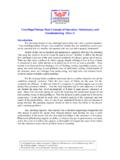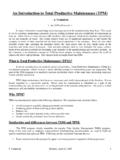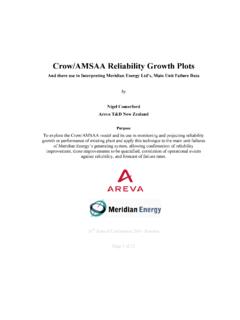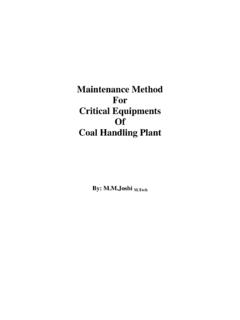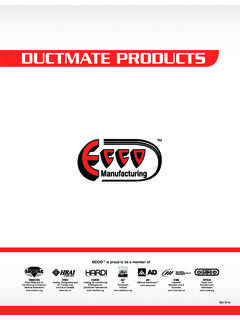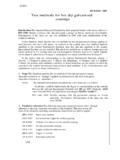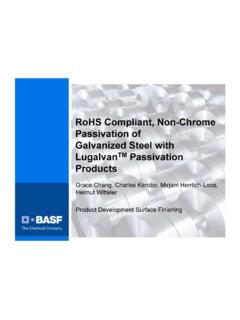Transcription of Some Failure Analysis Case Histories in Galvanized Steel ...
1 Some Failure Analysis Case Histories inGalvanized Steel ProductsDr. Zamanzadeh and Ed Larkin Matco Associates, Pittsburgh, PAAbstract: The three case Histories presented in this paper concern defects and causes of failureassociated with Galvanized Steel sheet material. Optical metallography and microindentationhardness testing were the principal methods employed in determining the causes of Failure butwere supplemented as necessary by scanning electron microscopy and energy-dispersive of the case Histories presents defects associated with the actual hot-dip galvanizing processitself. In one instance, tiny hydrogen blisters were observed to have occurred at oxide scaledeposits at the interface between the Steel and Galvanized Galvanized sheet Steel cracks in bending during forming operations, most end users tend toplace the blame on the Galvanized material. However, several separate investigations of formedand cracked Galvanized Steel parts have revealed that the cracking often initiates at the shearededges of the part where plastic deformation has produced a local increase in hardness and acorresponding decrease in ductility.
2 Ductility is the property of Steel required to successfullywithstand forming final case history present some observations made during Failure Analysis of corrodedgalvanized and painted panels at a utility plant. The coating system was composed of agalvanizing layer, a thin primer, and a final top coat. The problem was identified as localizeddevelopment of white rust. The problem was found to be caused by the presence of a second-phase precipitate in the galvanizing layer that adversely affected its ductility allowing it to crackduring forming. This produced localized stress in the paint layer that then cracked, permittingmoisture to come into direct contact with the zinc, resulting in white rust : Galvanized Steel , failures (materials), intergranular precipitation, hydrogen blisters,forming problems, metallography, metallurgical specimens, microstructure, BackgroundCenturies before zinc was discovered in the metallic form, its ores were used for making metallurgists probably lost this volatile metal as vapor because their apparatus was notdesigned for condensing it.
3 Metallic zinc is not an easy metal to produce. Zinc oxide cannot bereduced by charcoal at temperatures below 1000 C. However, zinc boils at 923 C and the metalis, therefore, produced as a vapor that must be collected and is claimed that China first produced zinc in the period 200 to 100 As far as China isconcerned, there is a reference in a textbook on metallurgy, dated to 1637, for the production ofzinc in sealed crucibles. Zinc was even used for coinage during the Ming dynasty (1368 to 1644).There is considerable evidence of the production of zinc in India between the tenth and sixteenthcenturies. At Zawar, near Udiapur in Rajasthan, great heaps and walls of small retorts have beenfound recently. It is estimated that the elliptical retorts found at Zawar represent the extraction of100,000 tons of metallic before zinc was smelted in Europe, it was being sold there by Portuguese and Englishtraders who brought it from the Orient.
4 Zinc was being imported by the East India Company fromabout 1605 onwards. At this time, the zinc was added to copper to make ores are often contaminated with zinc because the two metals occur together. Smallamounts of metallic zinc were obtained as a by- product of the lead industry and Agricolamentioned the formation of "zincum" in the furnaces of Silesia. This is probably the first indicationwe have in the West of any attempt to recover metallic zinc. The credit for the first intentionalproduction of metallic zinc in the West is given usually to William Champion who developed avertical retort method in 1718. Rows of horizontal retorts, which are more thermally efficient and,therefore, more economical, were installed by the Abbe Dony at Liege, Belgium in first recorded experiments for producing zinc coatings by the dipping process are those of aFrench chemist, Melouin, in 1741. Tinned iron was already known at that time and Melouinattempted to zinc coat iron sheets in a similar manner by immersion in a bath of molten zinc.
5 Theresults of his experiments formed the basis of a report to the Academie Royale in 1742. Interestin Melouin's discovery spread through the scientific circles in Paris. The first application that wasattempted was to use molten zinc as a cheap protective coating for household utensils. Zinc wasused to replace tin, which had become too expensive for the poor. In 1742, Jean-BaptisteKemerlin applied this process for coating iron kitchen utensils and these products were fairly wellknown in parts of France during the second half of the eighteenth century. In 1778, however, itwas discovered that the zinc became corroded by organic acids and that the salts found on thezinc were poisonous. Interest in hot dipped zinc coatings then 1780, the Italian, Luigi Galvani, discovered the electrical phenomenon of the twitching of afrog's leg muscles when contacted by two dissimilar metals, namely, copper and iron. Galvaniincorrectly concluded that the source of the electricity was in the frog's leg.
6 Experiments withdissimilar metals were further pursued by another Italian, Alessandro Volta, who came to believethat the flow of electrical current was caused by the contact of the dissimilar metals 1800, Volta was able to prove this by constructing a stack of alternating zinc and silver plateswith a piece of cloth soaked in a salt solution between the individual plates. This device, knownas Voltaic pile, was the world's first of zinc in the laboratory occurred in 1800, the same year that Volta developedthe voltaic pile. In September of that year, The German physicist, Johann Ritter, used Volta'sbattery to deposit zinc on iron. In 1805, an early British patent was issued to Charles Sylvester, and John Moorhouse for a method of coating nails and bolts by placing themin a galvanic pile with zinc and seawater. Full commercial utilization of zinc plating processes hadto wait until the end of the nineteenth century until electric dynamos and generators 1824, Sir Humphrey Davy showed that when two dissimilar metals were connected electricallyand immersed in water, the corrosion of one was accelerated while the other received a degree ofprotection.
7 From this work he suggested that attaching iron or zinc plates to them, the earliestexample of practical cathodic protection, could protect the copper bottoms of wooden naval wooden hulls were superseded by iron and Steel , zinc anodes were still used. In 1836,Sorel in France took out the first of numerous patents for a process of coating Steel by dipping itin molten zinc after first cleaning it with 9% sulfuric acid and fluxing it with ammonium chloride. Heprovided the process with its name "galvanizing". It is interesting to note that Sorel was aware ofthe electrochemical nature of corrosion and the sacrificial role of the zinc coating on the , the word galvanizing did not refer to the process of coating but to the fundamentalproperty offered by this addition to Sorel's patent of 1836, A British patent for a similar process was granted in 1837 toWilliam Crawford. By 1850, the British galvanizing industry was using 10,000 tons of zinc a yearfor the protection of Steel .
8 Early corrugated Galvanized Steel used a roofing material, found its wayto both Australia and California during the gold rush of the beginning, individual sheets of iron had to be hot-dipped by hand. The Sendzimir coatingprocess was the first to attain commercial success by fulfilling the basic coating requirements in acontinuous galvanizing operation. A coating line was installed by the Armco Steel Corporation atButler, Pennsylvania in 1936 and proved the soundness of the process. Metallurgically, thisprocess suppresses the formation of the brittle iron-zinc alloy layers at the Steel -coating interfaceby the addition of aluminum to the bath. By minimizing the thickness of the brittle iron-zincalloy layers, the ductility of the coating is improved. The beneficial effects of aluminum alloyadditions to the zinc bath were first discovered in the early twentieth century, and research in thisarea was later performed by Bablik and History 1 Several pieces of Galvanized Steel strip were experiencing a problem with the Galvanized blisters were observed on both sides of the sheet.
9 The strip was first passed through afurnace to oxidize and remove any oil residues. The strip was then annealed in a furnacecontaining a hydrogen atmosphere and finally hot-dip InspectionThe hot-dipped Galvanized coating on both sides of the Steel strip possessed numerous verysmall blisters. The blisters were distinguishable by an increase in reflectivity caused by theirraised surfaces. It was found that rubbing the blisters with a fingernail or other object would flattenthe zinc coating over the blister and so eliminate InspectionTransverse sections through the Galvanized Steel in the blistered areas were prepared forsubsequent metallographic inspection. In the as-polished condition, the blisters were observed assmall arches in the coating with complete separation occurring at the zinc- Steel interface (Fig. 1).At high magnifications, small gray inclusions were observed on the Steel surface within the cavity(Fig.)
10 2). The inclusions were examined using a scanning electron microscope equipped with anenergy dispersive X-ray spectrometer. Only iron was observed. The equipment cannot detect thepresence of elements in the first row of the periodic table such as carbon, oxygen, nitrogen, upon the appearance of the inclusions, and the absence of any elements other than iron,the inclusions are most likely iron 1: Photograph at 200x showing a blister under the Galvanized coating as 2: Photograph at 500x showing scale particles within a blister as blisters in the Galvanized coating appear to have been caused by gas accumulation at theinterface between the Steel and the zinc coating. Iron oxide inclusions were observed within theblister cavities. The following mechanism is responsible for the blistering problem: (1) the as-received Steel strip probably was incompletely pickled, which left iron-oxide scale at small isolatedlocations; (2) during pickling and later annealing, hydrogen was absorbed by the Steel ; (3) duringgalvanizing, the heat from the molten zinc caused the hydrogen to diffuse out of the Steel ; (4) atlocations where surface oxides existed, the atomic hydrogen was able tot recombine to formdiatomic molecular hydrogen gas that raised the surface of the coating, forming the eliminate this problem, it was suggested that the surface oxides be eliminated will not prevent hydrogen absorption but should prevent the formation of gas blisters whenthe hydrogen diffuses out of the Steel during History 2 One section of a formed (bent) Galvanized Steel sheet cracked during bending.


